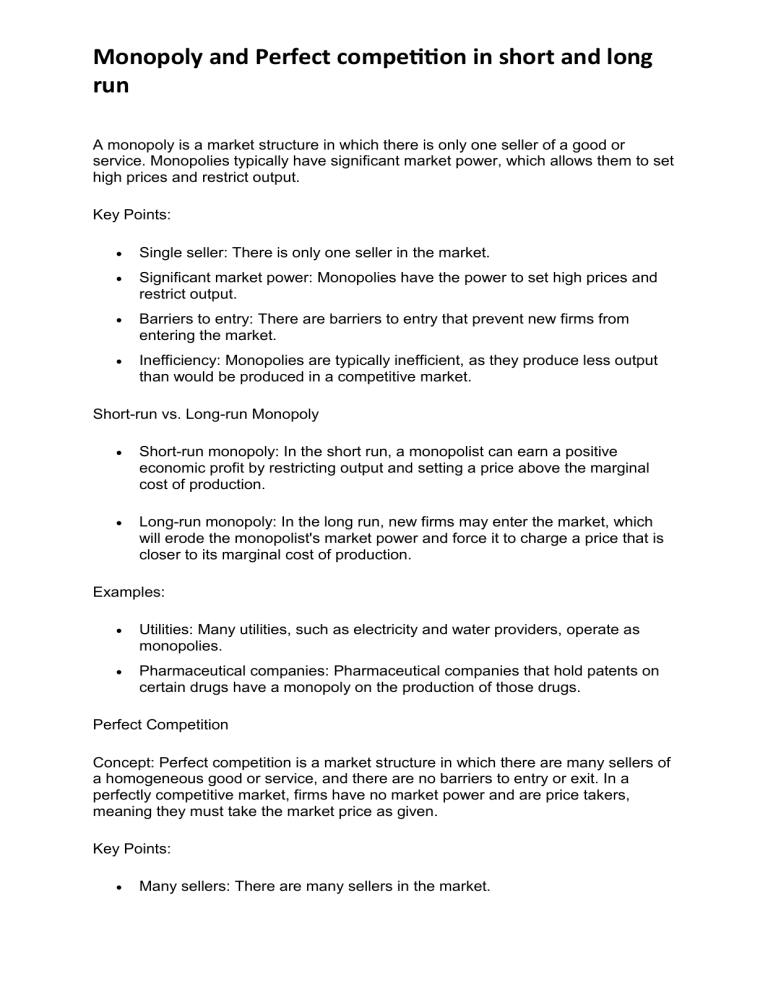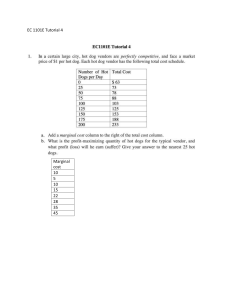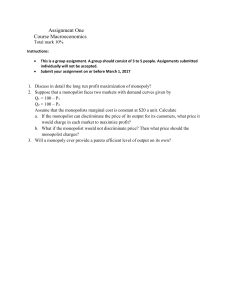
Monopoly and Perfect competition in short and long run A monopoly is a market structure in which there is only one seller of a good or service. Monopolies typically have significant market power, which allows them to set high prices and restrict output. Key Points: Single seller: There is only one seller in the market. Significant market power: Monopolies have the power to set high prices and restrict output. Barriers to entry: There are barriers to entry that prevent new firms from entering the market. Inefficiency: Monopolies are typically inefficient, as they produce less output than would be produced in a competitive market. Short-run vs. Long-run Monopoly Short-run monopoly: In the short run, a monopolist can earn a positive economic profit by restricting output and setting a price above the marginal cost of production. Long-run monopoly: In the long run, new firms may enter the market, which will erode the monopolist's market power and force it to charge a price that is closer to its marginal cost of production. Examples: Utilities: Many utilities, such as electricity and water providers, operate as monopolies. Pharmaceutical companies: Pharmaceutical companies that hold patents on certain drugs have a monopoly on the production of those drugs. Perfect Competition Concept: Perfect competition is a market structure in which there are many sellers of a homogeneous good or service, and there are no barriers to entry or exit. In a perfectly competitive market, firms have no market power and are price takers, meaning they must take the market price as given. Key Points: Many sellers: There are many sellers in the market. Monopoly and Perfect competition in short and long run Homogeneous good or service: The goods or services produced by all firms are identical. No barriers to entry or exit: There are no barriers to prevent new firms from entering the market or existing firms from leaving the market. Price takers: Firms have no market power and must take the market price as given. Short-run vs. Long-run Perfect Competition Short-run perfect competition: In the short run, firms in a perfectly competitive market may earn positive or negative economic profits. Long-run perfect competition: In the long run, firms in a perfectly competitive market will earn zero economic profit. This is because entry and exit will drive the price down to the point where firms are just covering their costs. Examples: Agricultural markets: Agricultural markets, such as the market for wheat or corn, are often cited as examples of perfectly competitive markets. Financial markets: Financial markets, such as the stock market or the bond market, are also often considered to be perfectly competitive. Matrix Calculation Example Consider a monopoly that produces widgets. The monopolist's marginal cost of production is $10 per widget, and the market demand for widgets is given by the following equation: Q = 100 - 2P where Q is the quantity of widgets demanded and P is the price of widgets. To maximize its profit, the monopolist will set a price at which marginal revenue equals marginal cost. Marginal revenue is the additional revenue that the monopolist can earn by selling one more widget. The formula for marginal revenue is: MR = dR / dQ where R is the monopolist's total revenue. In this case, the monopolist's total revenue is given by: Monopoly and Perfect competition in short and long run R = PQ Substituting this into the formula for marginal revenue, we get: MR = P + Q * dP / dQ Since the monopolist is setting a price above the marginal cost of production, the demand curve is downward-sloping, so dP / dQ is negative. Therefore, we can rewrite the formula for marginal revenue as: MR = P - Q Setting marginal revenue equal to marginal cost, we get: P - Q = 10 Substituting the market demand equation into this equation, we get: P - (100 - 2P) = 10 Solving for P, we get: P = 30 Substituting this price back into the market demand equation, we get: Q = 40 Therefore, the monopolist will produce 40 widgets






